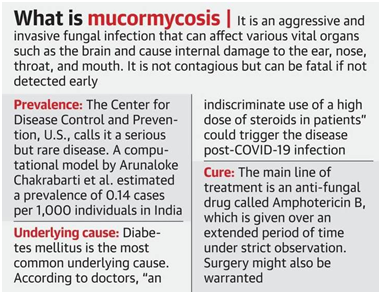Context
The Union government has asked the States to declare mucormycosis, the fungal infection being reported in COVID-19 patients, an epidemic.
About the declaration of mucormycosis as epidemic
- The Union Ministry of health and Family Welfare requested to make mucormycosis a notifiable disease under Epidemic Diseases Act 1897.
- Use: Declaring the black fungus infection seen in COVID-19 patients an epidemic would lead to health facilities screening for it and reporting all such cases to the government.
- Reasons: It is a new challenge in the form of a fungal infection, namely mucormycosis.
- It has emerged and is reported from many States amongst COVID-19 patients, especially in those who are on steroid therapy and deranged sugar control.
- This infection is leading to prolonged morbidity and mortality amongst COVID-19 patients.
- Rajasthan, Telangana and Tamil Nadu have declared it an epidemic.

Epidemic Diseases Act, 1897
- This was first enacted to tackle bubonic plague in Mumbai in former British India.
- The law is meant for containment of epidemics by providing special powers that are required for the implementation of containment measures to control the spread of the disease.
- A disease can be declared as epidemic by State or Central government.
Earlier use of the Act
- In 2018, the Act was enforced as cholera began to spread in a region of Gujarat.
- In 2015, it was used to deal with dengue and malaria in Chandigarh .
- In 2009 it was invoked in Pune to combat swine flu.
- In 2020, in order to limit the spread of coronavirus disease 2019 during the COVID-19 pandemic in India
|
